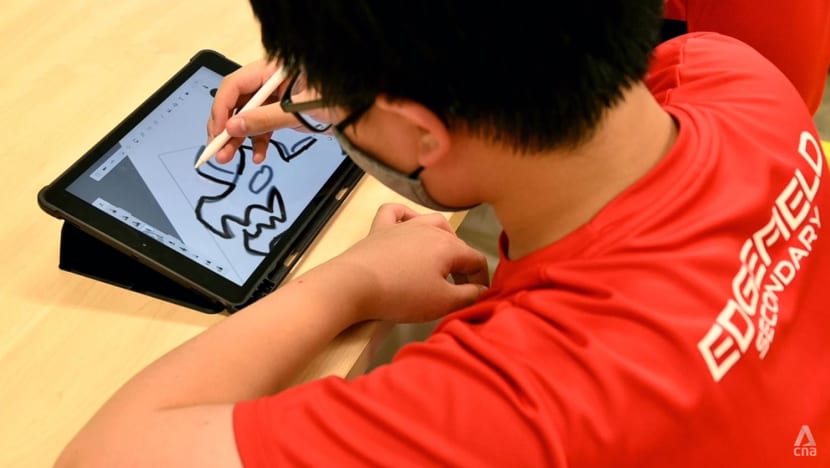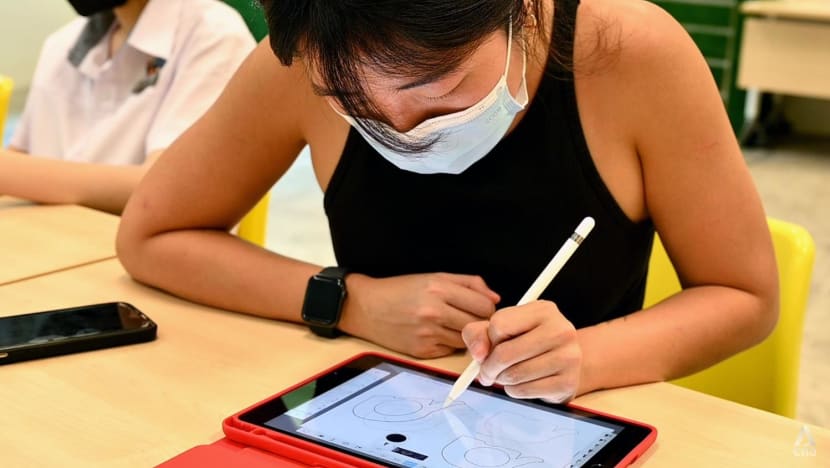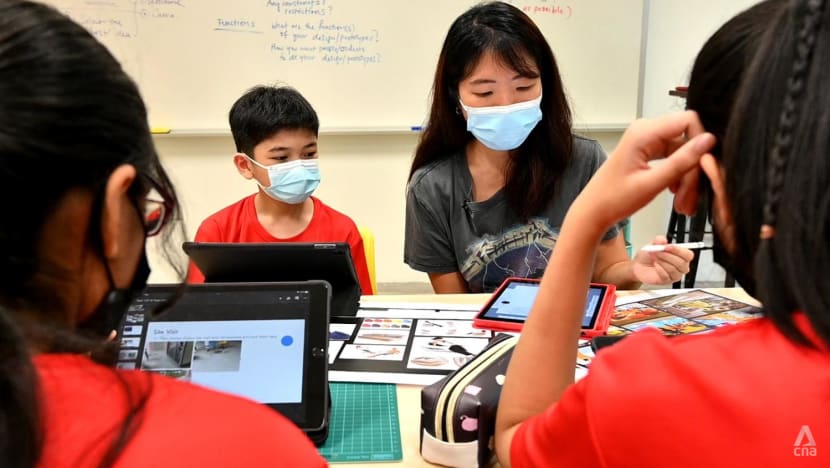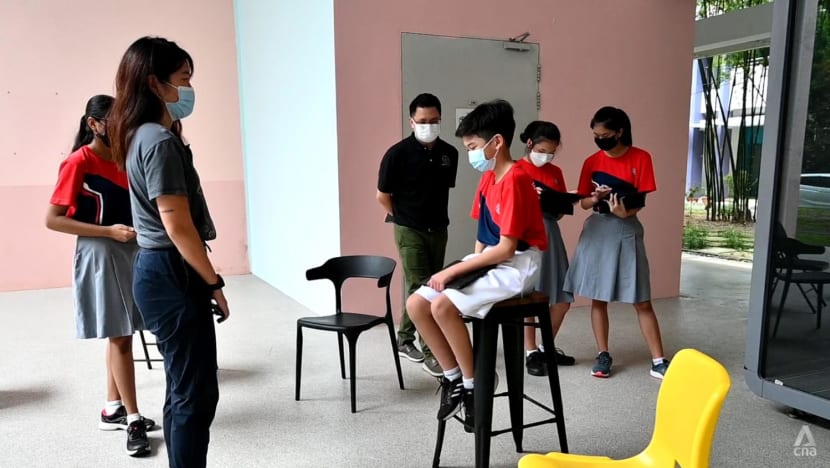Back to school: How the updated Design & Technology curriculum trains students for life
In the second article of a three-part series looking at how lessons in Singapore's schools have evolved, CNA journalist Grace Yeoh went back to the classroom to find out whether Design & Technology lessons still involve buffing plastic, filing woodwork and sketching with pencil on paper.

CNA journalist Grace Yeoh sits in on a design & technology lesson with a Secondary 2 class at Edgefield Secondary School. (Photo: CNA/Jeremy Long)
SINGAPORE: “Eh 'cher, you know you can do it this way,” says my 14-year-old seatmate to me, as she peers over my arm at my iPad screen.
“Do what?” I ask gingerly, recognising the bemusement in her voice that I too have when I observe people older than me struggle with technology. “You show me?”
My classmate for the day and Generation Z extraordinaire, Deon Lim, chuckles and pauses work on her iPad. She leans over my arm to help me split my iPad screen.
This split view will allow me to have the Sketchbook app on the left, while scrolling through my photos on the right to see which photos to insert, without switching entirely from one app to another.
“Easier this way,” she quips before turning back to her work.
Deon has helped me with a shortcut that should have been intuitive to me, an Apple user for more than a decade and a born multitasker. But it doesn’t occur to me to split my screen because I am too busy trying to sketch something remotely passable on an iPad – a task that’s proven unexpectedly challenging.
Despite my background in art and my significantly lowered standards for what constitutes “passable”, it is clear that Design & Technology (D&T) lessons these days are not what they used to be.
A few CNA journalists revisited certain subjects – Geography, D&T and Science – for a three-part series on how lessons have changed since we were secondary school students. For the second part of this series, I spent two D&T lessons with Secondary 1 and 2 classes from Edgefield Secondary School.
Some things have not changed. Teenagers are still stubborn; my classmates refused to call me by my name despite my insistence to treat me like one of them. Also, as my interaction with Deon reminded me, I still don’t like to ask for help.
But one thing is evidently different: Technology that wasn't even invented when I was in secondary school is now used to complete basic assignments.
MOVING BEYOND METALWORK AND WOODWORK
As much as I preferred working with pencil and paper, replacing old school materials with an iPad – or “personal learning device” as it’s called – is expected compared to the more drastic changes since D&T’s inception.
Before D&T was implemented, woodwork and metalwork were taught during the 1970s to 1980s. These subjects were attended by boys, while girls would attend home economics where they learnt sewing and cooking, said Mr Sin Kim Ho, the Divisional Director of Curriculum Planning and Development Division 1 at the Ministry of Education (MOE).
Then in 1986, D&T was introduced to Express and Normal (Academic) students as a compulsory subject at the lower secondary level, in response to Singapore’s changing economic landscape.
When the Normal (Technical) stream was started in 1994, students in this stream were offered Technical Studies (TS) while D&T continued to be offered to the other students, MOE said in a separate response.
Both TS and D&T remained compulsory at lower secondary levels and elective at upper secondary levels until 2007, when the subjects underwent a review. D&T was then offered to all students to "support the shift towards designing and making". As an elective subject at upper secondary levels, however, schools made "school-based decisions" on whether to offer the subject.
“We moved into more emphasis on design thinking as we evolved and developed the subject. This is really very much in tandem with the kind of skills that our students will need when entering the workplace,” said Mr Sin.
He added that with all subjects, including D&T, major curriculum reviews are typically done every six years. After any change is implemented, a midterm review is carried out to get feedback from schools.
And if there are “particular circumstances that coincide with major initiatives or direction in MOE”, the ministry conducts “tweaks to the implementation cycle”.

Unfortunately, despite having studied D&T in the early 2000s, I barely recall the design thinking involved. I was way more interested in learning how to use a plastic buffing machine, as much as I questioned when I’d ever need that skill in life.
About 18 years later, I don’t remember what happened to the green and orange pencil holder I made with the machine nor, frankly, the last time I used a pencil. But I still remember my excitement whenever D&T lessons rolled around.
If memory serves me right, homework involved design drawing and filing woodwork – engaging hands-on assignments that were a breath of fresh air compared to other more theoretical subjects.
Still, the subject never felt like a priority compared to the “main” ones, such as English, maths, science and mother tongue languages.
Since my school only offered D&T to upper secondary students in the Normal stream, I assumed I’d never again see a plastic buffing machine after Secondary 2. I was right about that – but not about my impression that D&T was irrelevant.
After all, sitting in class with students less than half my age almost two decades after I thought I’d left D&T in the dust, I realised that the subject is actually one of the most applicable beyond school.
“The kind of skills that students learn in D&T in all processes, like ideation, (require them) to actually … think about how they go about making something real to solve a particular problem they’ve identified. Some of these problems have to be based on real-world situations. So it is very much a departure from what it was,” said Mr Sin.
“We try to make (the subject) real, try to make it relevant, and most importantly, (teach) skills that are going to transfer into the future.”
When designing the D&T curriculum, MOE balances timelessness and timeliness. D&T soft skills like creativity and innovation are “attitudes that one can carry in life”, and could spark “wonderment” later on, added Mr Sin.
On the other hand, there also needs to be the “element of timeliness”, as technology is ever-changing.

SKETCHING ON AN IPAD
One of the class assignments I was given centred around such technology: Design a wooden coin bank using the Sketchbook app. The project was anchored on the theme of wildlife conservation, so our coin banks were drawn to resemble endangered animals.
To sketch our coin bank, we would have to use “shape borrowing techniques”, as well as “underlays” to produce a 3D rendered presentation of our coin bank. I hoped I made the right choice to draw an elephant, since the animal’s outline wasn’t too complicated.
While the activity seemed like something I could have done in school, the key difference was that I couldn’t do it with colour pencils and a sketchbook. Having previously attempted to sketch on an iPad, I was nervous. The absence of “friction”, usually present with pencil against paper, takes some getting used to.
As Mdm Elsie Cheng, Head of Department for Craft and Technology at Edgefield Secondary School, went through the steps of creating an initial sketch, I observed my classmates seamlessly swish from one app to another while using tools in the Sketchbook app to create remarkably professional sketches.
Meanwhile, I was figuring out how to adjust the thickness of my brush. I eventually also discovered how to draw a perfectly straight or curved line with the ruler tool, and transform my elephant sketch from 2D to 3D. But my sense of pride evaporated when Mdm Cheng instructed us to render our sketch.
Somewhere in between using an airbrush to colour over the sketch and retracing my outline with a thicker brush, my elephant ended up looking more diseased than designer. In comparison, the example images Mdm Cheng projected on screen could have come straight from a Pixar film. There was no way anyone could achieve those in the remaining 30 minutes of class, I thought.
Several minutes later, I found people who could. My classmates, including Deon, produced “rough” sketches that would have easily secured them an animation job. I later learnt that it was also their first time drawing on an iPad.
GOAL IS NOT TO GET STUDENTS TO BE A DESIGNER
After class, my classmate Marizztellah de Guzman told me she found the assignment “really challenging” because she’s “not very good at art”.
She said her class had done a similar assignment in Secondary 1 – on pen and paper. Yet, despite the challenge to “try and translate what you’ve learnt from last year”, she felt that she could better express what she wanted to draw now because the Sketchbook app provided more tools.
Similarly, another classmate, Tessa Tay, said she learnt resilience from trying to adapt to an unfamiliar medium. She and her classmates “persevered and pushed through, and we manage to do what the teacher has assigned us to do”.
Mdm Cheng, who has taught D&T for 18 years, reassured me that the goal of D&T is “not to get (students) to be a designer”. Rather, it’s to think like a designer; to learn to apply the “framework of design thinking”.
“It’s a way of framing … the way you think. And you also get to empathise with users. Because in order to understand the problem, you actually need to go down to the user to understand what (the problem) is all about,” she said.
“Just like for this story itself. You, the journalist, come to the class to experience, in order to have a better (understanding) of what D&T is all about and what are the changes we’ve done over the years.”
She had a point. If I didn't embed myself in a secondary school class, I wouldn’t be able to write authentically about the changes in the D&T curriculum. Much like design thinking, the solution to understanding today’s curriculum required me to put myself in the user’s shoes.
Or in this case, their classroom.

According to online design school, Interaction Design Foundation, design thinking is “an iterative and non-linear process” which contains five phases: Empathise, define, ideate, prototype and test.
In design thinking, “the overall goal is to identify alternative strategies and solutions that are not instantly apparent with your initial level of understanding”. Thus, design thinking provides “a solution-based approach to solving problems which helps you do so in a creative and collaborative way”.
What struck me about design thinking is it was more than just a process; it was an entire way of thinking. It’s a mindset that shifts the focus from the self to others. In doing so, it teaches empathy and open-mindedness, such as by getting designers to look at the problem from the user’s perspective to come up with the most effective solution.
Design thinking, therefore, seemed fundamental yet complex. Without first understanding its purpose, everything else in D&T could seem irrelevant and highly technical. But it also seemed too abstract for 13-year-olds. After all, I wasn’t exposed much to it at 13.
And then I met today’s 13-year-olds.
DESIGN THINKING IN ACTION
In my activity with the Secondary 1 class, we were tasked to develop a proposal to refurbish a common space in the school called the Da Vinci Hub, using skills from an assigned subject (D&T, art or food and consumer education).
The class was divided into nine groups, with three groups each focusing on one of the subjects. I was assigned to a D&T group.
The activity sounded like it could have been part of an architecture or entrepreneurship course in a polytechnic, but I wasn’t complaining. It seemed to strongly emphasise design thinking skills, like creativity, critical thinking and empathy.
Within minutes, my 13-year-old bosses brought me up to speed on the brainstorming they had done to turn the Da Vinci Hub into a hangout space for fellow students.
We sieved through multiple photos of possible furniture for the space, narrowing down the best options based on aesthetics and purpose. I hadn’t been involved in their research, but they readily took my opinions into account when making decisions and easily navigated compromise.
For example, when I suggested a chair that would allow students to sit cross-legged in order to reduce restlessness and hyperactivity, my groupmate Lai Kit Wan expressed appreciation because she hadn’t considered that user experience. Her simple gesture made me feel heard.
But more importantly, it reminded me that there is no right or wrong answer in D&T or at least in design thinking, unlike in many other subjects. The various stages of iteration force you to get comfortable with ambiguity, uncertainty and change – a skill more valuable than any A-grade.

The second part of the activity took us down to the Da Vinci Hub itself for a site recce. While there, we tested out several chairs and took measurements of the space to draw up a potential floor plan when we returned to class.
Back in class, another groupmate Anya Leong suggested building an elevated platform so students who wanted to chill could have a separate space from those who wanted to study or discuss homework. This “second storey” platform would include beanbag chairs and a shelf with board games and books that students could donate.
Anya’s idea was out-of-the-box, considering most people would plan around the existing floor space, and I wouldn’t have been surprised if her teammates turned it down.
But no one did. It was received with enthusiastic approval.
“What I found most interesting was brainstorming ideas, and then just putting it out. You can just be imaginative and have the craziest ideas, but you can just narrow it down (later). So one of the crazy ideas was we made a second storey. There was actually very interesting,” my group leader Ilhan Qhairie told me after class.
Ilhan, who is in the school’s entrepreneurship club, found that figuring out what other people would like in the space was the challenging part of the assignment.
“Because we can't do an entire survey and ask the entire school, so we just had to think and try and put ourselves in their shoes,” he said.
“When we visited the site, what I thought first was, ‘Would I use it myself?’ But then after a while, I would think, ‘Would other people use it as well?’ So I would take the ideas of my other groupmates and then even yourself.”
My other groupmates echoed Ilhan. Yet, in admitting they found it challenging to think from the user’s perspective, they inadvertently demonstrated qualities of design thinking – mature thought and an understanding of empathy – proving that design thinking isn’t a complex undertaking. At its core, it essentially requires you just to be human.

WHAT MAKES A GOOD D&T STUDENT?
When I first embarked on this assignment, I secretly hoped to excel in class. I even planned to ask the teachers what makes a "good D&T student", hoping I would be able to meet these tangible goalposts.
But after two days of getting completely humbled by adolescents and the updated D&T curriculum, I came away with a newfound appreciation for our rigorous education system – and the fact that I was no longer a student. I also ended up shedding dated beliefs about myself.
After all, what makes a student excel at D&T is not their technical ability, even though that is an undeniable advantage. Instead, it’s their willingness to try despite the odds.
This is generally a good life skill, but it is particularly important in a subject that’s grounded in ideation and experimentation, where most initial ideas might be rejected or refined. And with the nation’s concerted effort to move away from a results-oriented education system, the ability to prioritise the journey rather than the outcome cannot be overstated.
“Some students come to us with the mindset that they can’t draw. It’s a phobia to them,” shared Mdm Cheng.
“They may not be the best students, but somehow they are willing to try and they’re willing to work hard. They may not be at a certain baseline, but through the different design strategies that we use, they are still able to complete the project during a stipulated time. I think that’s a major success to them.”
Such students who tend to excel at the subject also constantly question everything, another D&T teacher, Mr Ng Teck Yeong, pointed out.
“I think the inquiry part is very important … the questions they ask themselves consistently in the mind. They don’t stop when they reach the final design. There’s always this mindset that there’s something they can work on and improve on the design,” he said.
“Students who excel in D&T are always questioning themselves, questioning how the product and the design actually relate to the user, the environment and the function that the designer intended it for.”
Mr Ng added that he has Secondary 5 students who challenge him regarding their design, and he encourages such behaviour.
“Basically, they’re taking ownership of their design and questioning themselves, and not just accepting what I tell them.”
My two days back in school were too brief to be proficient at rendering sketches or even remembering to create a new layer every time I wanted to sketch a new object. But I did learn skills far more applicable, both from my teachers and my classmates who ended up being teachers in their own right.
Mainly, how to be comfortable with the discomfort of feeling inadequate. This is a feeling that will keep coming up in a subject where the ability to try and fail and try again and fail again forms its crux. Embracing failure as part of the iterative process is crucial in design thinking.
As someone who finds it hard to beat perfectionism, knowing it is not possible or ideal to attain perfection in D&T, a subject where there is always room for improvement for the user, can be liberating. It’s also a necessary reminder that you don’t have to excel at things to enjoy doing them.
Days after I wrapped up my time with the school, I kept returning to Mdm Cheng’s instructions on how to draw our initial sketch. She had cautioned the class not to sketch something too elaborate, too perfect, as she only required an outline.
And I recalled how my own D&T teacher 18 years ago had said we didn’t need to polish every single scratch off our plastic pieces, even as many of us tried. We didn’t have to make it perfect.
As much as many things have changed in the curriculum since I was in school, perhaps the most important lessons have not.















